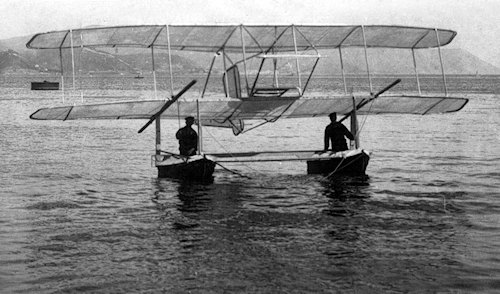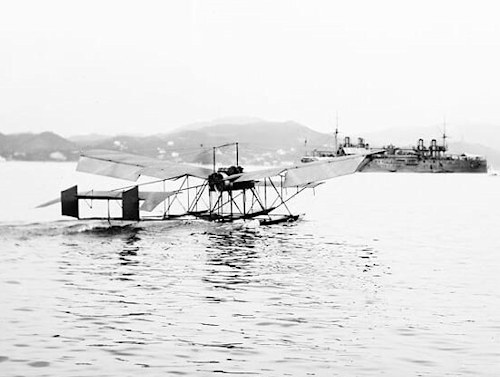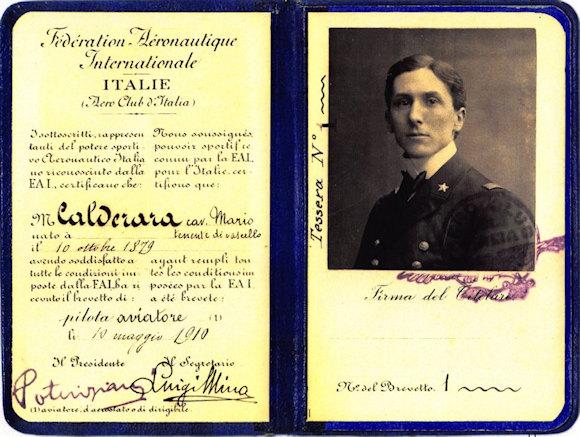Mario Calderara (1879 – 1944) was an inventor and aviator, the first Italian to obtain the flight license in 1909, and to build the first seaplane in 1911.
The first of three children of General Marco Calderara and Eleonora Tantini, since he was a child he was attracted by the seafaring life.
In 1898 he was admitted to the Naval Academy of Livorno.
Already from his first boarding as a cadet on the training ship "Flavio Gioia", Mario was attracted by the flight of seagulls and began to study their evolutions. In particular he was struck by the short stretches of hovering against the wind they did.
Appointed ensign in 1902, as his first destination he was embarked on the battleship "Sardinia".
Meanwhile, on December 17, 1903 in the United States, the Wright brothers' studies and experiences came to a positive conclusion, which led them to make the first official powered flight in history with a vehicle heavier than air. He corresponded profusely with the Wright brothers, beginning a lifelong friendship.
In 1905 he was able to launch kites first from a raft, then from a motor boat, towed against the wind. They were the first of a long series of experiments that he made with different types of "hydrogliders" that he designed and built.
 In 1907 Admiral Mirabello (1847-1910) granted the authorization and in February 1907 in La Spezia, built a first model of biplane which in general lines imitated (without engine) the Wright brothers' device.
In 1907 Admiral Mirabello (1847-1910) granted the authorization and in February 1907 in La Spezia, built a first model of biplane which in general lines imitated (without engine) the Wright brothers' device.
During the experiments with the biplane towed by the "Lancer", it first reached an altitude of over fifteen meters, but then fell into the sea, the hydroglider was destroyed and Calderara suffered bruises and injuries of a certain gravity. In 1909 the Aero Club of Italy, and Major Maurizio Mario Moris (1860-1944) invited Wilbur Wright to Rome, who gave Calderara some flying lessons with his plane.
Following Calderara's successes on the Brescia circuit, organized by the Aero Club of Italy, he was awarded the pilot license n. 1. In the same year he made two notable flights for the time: one of 35 and the other of 40 minutes.
In January 1910 the Ministry authorized the creation of an aviation school for soldiers and civilians in Centocelle and entrusted its management to vessel lieutenant Mario Calderara. On June 10, 1911, the Navy approved and authorized the construction of the Calderara seaplane prototype at the La Spezia Arsenal.

Calderara is to be considered the first Italian seaplane project worthy of the name. It was a high-braced wing monoplane. The metal lattice fuselage was equipped with two enclosed cockpits. The foothold on the water consisted of a central float and four auxiliary floats.
The engine, a 100 HP Gnome rotary radial, installed at the rear of the cab, drove a two-bladed pusher propeller. The largest in the world at the time, which took off in the spring of 1912 in the Gulf of La Spezia, carrying three passengers in addition to the pilot.
The First World War was upon us and the Navy forced Calderara to interrupt its aeronautical activities, and to return to its naval service duties. During the war, Calderara was embarked on various warships, the last destination in command of a torpedo boat in the Adriatic.
At the end of 1917, the Ministry assigned him to command a new school for seaplane pilots on the shores of Lake Bolsena. The student pilots were officers of the American Navy (America had just entered the war) and the school carried out its activities throughout 1918 and up to the month of July 1919. Calderara's training of American pilots she was judged very worthy by the United States Navy, and awarded him the "American Navy Cross". In 1923, Calderara was appointed military attaché at the Italian Embassy in Washington.

Following the establishment of the Regia Aeronautica he was transferred to the new army with the rank of lieutenant colonel. He remained in the United States capital until 1925. In 1926, when he decided to leave active service, Calderara requested and obtained the reinstatement of his position as staff officer of the Regia Marina.
I then accept the offer Pioneer Instrument Company from New York. Firm that produced instruments and dashboards for airplanes; becoming as well as shareholder, director of the European branch based in Paris where he settled with his family.
On 21 July 1940 at almost 62 years of age, Calderara was recalled to service with the rank of frigate captain and destined to command the square of Fiume; he held this command for about a year then, in 1941 he was retired.
Calderara died suddenly in Rome of a heart attack on March 16, 1944, while the battle of Cassino was in full swing. Only the terse news of his death appeared in the newspapers of the time. Under normal conditions, the memory of him, a pioneer of hydro-aviation and the first Italian pilot, would undoubtedly have been given the honors that he amply deserved.
His wife, Countess Emmy Gamba Ghiselli, survived him for 38 years, contributing substantially to the collection of data and documents, which constitute her husband's historical legacy.
REFERENCES
F. Evangelisti – People of the air vol 5 – Editorial Olimpia 1994
Photo: calderara.com / poste












